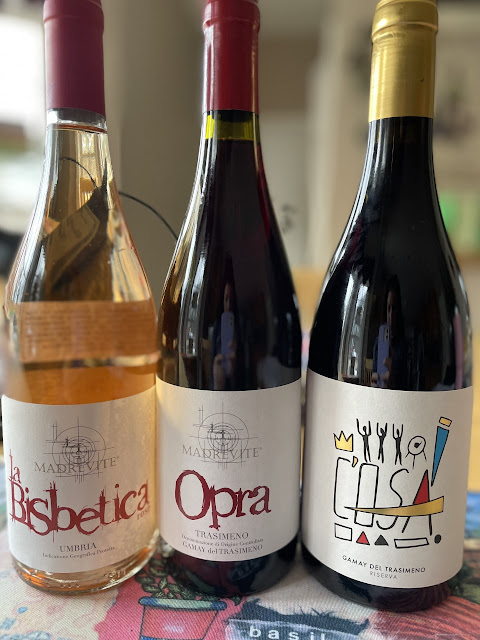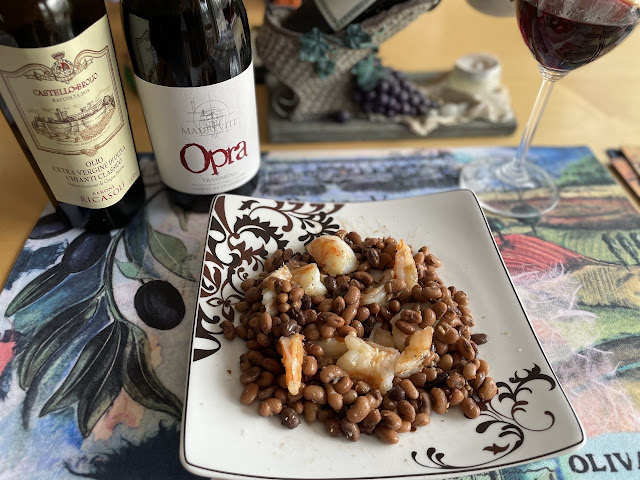It’s been a busy couple weeks and I’m back highlighting Slow Food and Wines of Italy for our theme this month with our Italian Food, Wine and Travel group (#ItalianFWT). Gwendolyn of Art Predator shared a great overview of what exactly is Slow Wine and Food when it comes to Italian wines.
Slow Food is an organization that started back in 1986 by
Carlo Petrini and other activists with the premise to “defend regional
traditions, good food, gastronomic pleasure and a slow pace of life”. If you’ve ever visited Italy this is one of
the things I enjoy the most. They way
many stay true to their traditions and just seem to enjoy the simple pleasures
of life. Some of the best meals of my
life have been in Italy over good food, long conversations with friends and
family. The way life should be!
Wine is also incorporated into this mix along with food and
Slow Food supports those wineries throughout Italy that are using traditional
methods in their winemaking, that also have respect for the environment in
which the grapes and protecting the grape varieties themselves. They
also have a guide that was shared with me that features over 2,500 wines from
over 300 wineries that pay close attention to quality, value and those that
have a high regard for protecting the environment throughout their
production.
The wines I’m sharing today are not featured in the most
recent Slow Wine guide, but Madrevite has been featured with one of their other
wines. These samples were shared with me
along with a Slow Food package that I cooked up this week. I chose to focus on the Gamay del Trasimeno grape
and wines since this is what Madrevite prides themselves on.
The Winery ~ Madrevite
The Madrevite winery began in 2003 and is comprised of 3
winemaking generations. The name
Madrevite comes from an ancient tool that was used to fasten shut wine
barrels. They selected this name to show
the relation between past traditions to the modern world. The winery is located in the municipal of
Castiglione del Lago in the Province of Perugia within Umbria. It borders closely the Tuscany border and is
set in the hills nearby to the Tuscan Lake Chiusi and Umbrian Lake
Trasimeno. Nicola Chiucchiuriotto is the
current owner and began the winery after restoring some of his grandfather Zino’s
old vineyards dating back to 1978. Nicola
explains him and his family as “farmers by experience, dedication and mission”.
Madrevite owns close to 150 acres with about 27 dedicated to
vines. The rest of their land consists
of forests, olive groves and crops including grains and legumes. Nicola works with a number of grapes
including Grechetto, Trebbiano and others, but Gamay del Trasimeno is the
featured grape of the winery. His aim is
to utilize what nature provides while focusing on environmental and economic
sustainability. He has chosen to
eliminate herbicides and pesticides along with improving the soil’s fertility
and increasing the biodiversity. Although
he is not certified he believes in the “model of life as a movement of
conscience rather than certification”.
This is something I personally can appreciate. As long as a winery is taking the right
measures to me a certification isn’t the end all be all.
The Wines
The Gamay del Trasimeno is a grape related to many others
and goes by many other names depending on it’s location. It’s most commonly also known as Garnacha or
Grenache, but is also called Tai Rosso in the Veneto and Cannonau in
Sardinia. It is believed that this grape
arrived to the area in the 1600’s by Spanish settlers. Nicole plants his Gamay grapes amid the top
of the hill on a small vineyard. His
grandfather Zino planted these in the 70’s by grafting ancient cuttings from
100+ year old vines.
These wines grow with a microclimate of mild winters and
warm, breezy summers due to the nearby lakes.
The average year of the vines are around 20 years old and grow on soils
based primarily of sand and clay with pebbles throughout.
I sampled 3 Gamay del Trasimeno wines from Madrevite: 2021
La Bisbetica Rose’, 2020 Opra and their 2019 C’osa Riserva. My favorite was actually their rose followed
by the Opra surprisingly over the riserva.
 |
The 2021 Madrevite La Bisbetica Rose’ Umbria IGP is
made 100% from Gamary del Trasimeno. The
grapes are manually harvested and spend about 6-8 hours in cold maceration
before softly pressed, clarified and fermented.
The wine spends 4 months in stainless steel and cement tanks on the lees
with another 3 months in the bottle.
Pale salmon in the glass leaning more towards orange. Floral on the nose with wild strawberries,
citrus and yeast. A mouthwatering
acidity lingering throughout the palate.
It’s refreshing mostly with strawberries notes that are crisp with a
puckering sour note. ABV 13%.
The 2020 Madrevite Opra Trasimeno DOC is also made
from 100% Gamary del Trasimeno. Manually
harvested with spontaneous fermentation without added yeasts. The grapes spend 10 months in cement tanks
with an additional 3 months in the bottle.
Translucent ruby in color with ripe raspberries on the nose along with toasted
marshmallow. Round, medium bodied with nice
acidity and nicely balanced. ABV 14%
Lastly, the 2019 Madrevite C’Osa Trasimeno DOC Riserva
was the final Gamay of the batch made from 100% Gamay del Trasimeno. Manually harvested 2-3 weeks after the
rose. The grapes spent 6 months in
cement with an additional 12 months in big barrel and cement with then 6 months
in the bottle. Translucent ruby in color
with sweet berries on the nose with again the toasted marshmallow notes. A more complex, earthy and a plush wine vs.
the Opra with raspberries, blackberries, black pepper with light to moderate tannin. ABV 15%
Madrevite also sent along a package of beans labeled Slow Food, so I thought this was the perfect opportunity to try them out with their wines. I prepared the beans along with some shrimp topped with some yummy Tuscan extra virgin olive oil from Castello di Brolio. I should've paired them with the other couple of wines they shared with me including a Grechetto and Trebbiano, but I wanted to sample through these Gamay for today's blog. They actually paired nicely with the beans. I'll be attending a virtual tasting with Madrevite on Monday so I may come back and add some more info or share it in a future post.
Join us live on Twitter at #ItalianFWT this Saturday @ 11am EST. Find more Slow Wine and Slow Food pairings from the following writers:
- Deanna delights with "Montenidoli Il Templare White Wine + Wood Fired Pizza" on Wineivore
- Camilla offers "Buono, Pulito, e Giusto: Lemon-Stuffed Chicken, Preserved Lemons, and an Umbrian Chardonnay" at Culinary Adventures with Camilla.
- Nicole goes on "Old World/New World Explorations of Malvasia"
- Wendy does "Spezzatino d'agnello and a G.D. Vajra Albe" for A Day in the Life on the Farm.
- Terri pairs "Grassfed Meatballs and Caiarossa Toscana" on Our Good Life.
- On Wine Predator, we argue that "Organic Famiglia Febo Deserves to be in Slow Wine Guide Italy"


I didn't get a copy of the pdf as it wasn't available until after my post was completed but Cam gave the best advice saying all Italian Food and Wine is slow LOL.....
ReplyDeleteCool beans! Great details in your article. I agree, these wines fit right in, but Slow Wine really wants to encourage certification. As a writer for Slow Wine CA, it can be hard to balance between returning wineries and finding new ones.
ReplyDeleteHow fun to have so many Slow Food/Wine things to try a once. The wines sound delicious as well!
ReplyDeleteCheers!